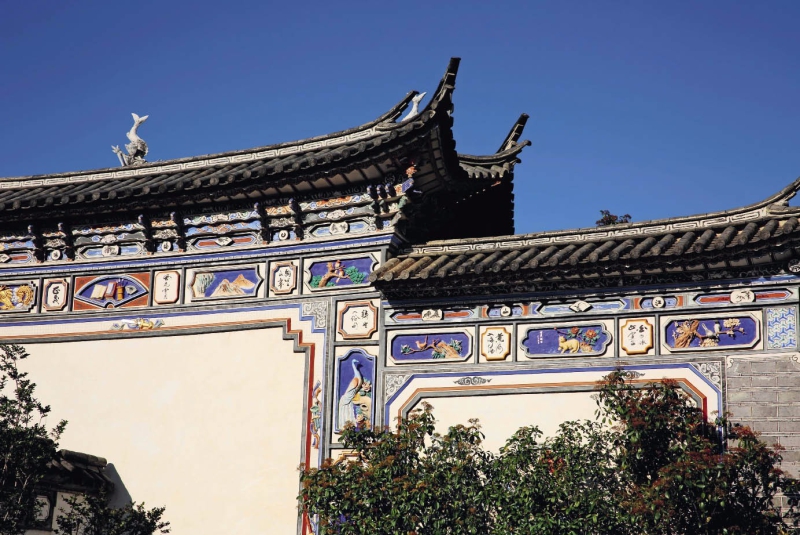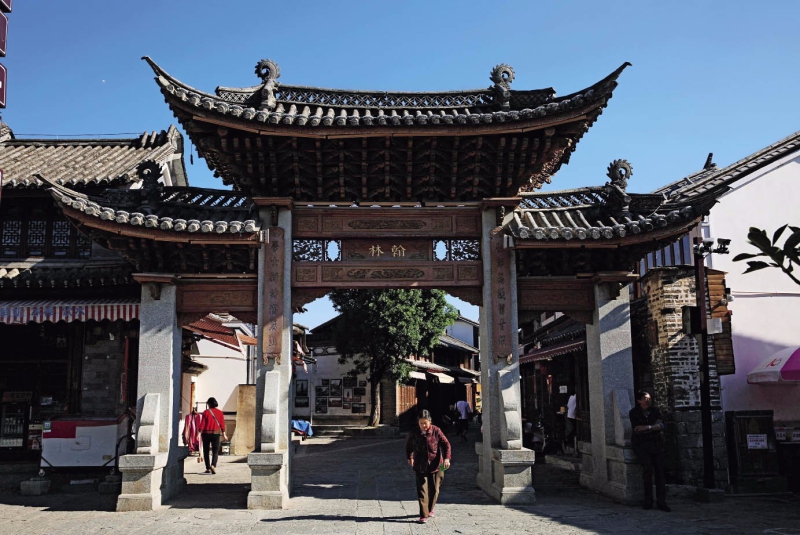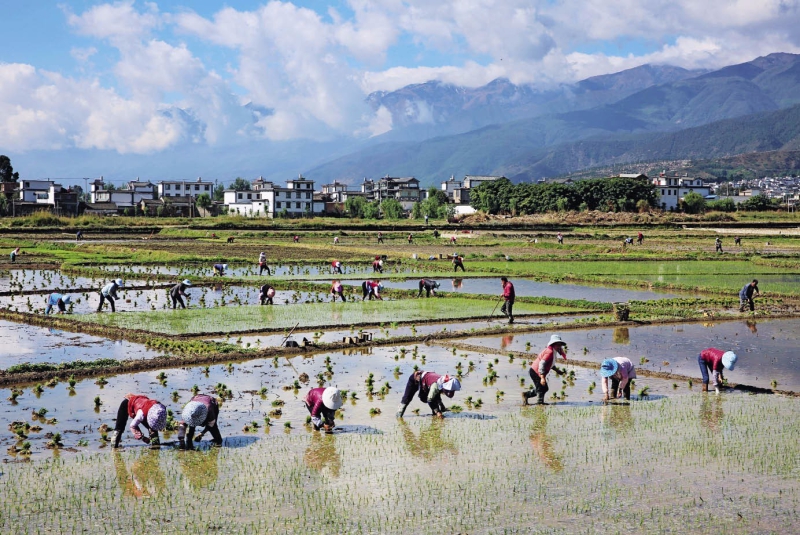Yan Mansion
In ancient times, Xizhou was a typical commercial town. Being a business hub, it maintained close economic and trade contact not only with other places in China, but also with southeast Asian countries.
The owner of the Yan Mansion is Yan Zizhen, a leading figure of the Xizhou business group who was influential in the 1940s. He was the founder of the Yongchangxiang Firm and the tuocha tea. After decades of hard work, the assets of the Yan business empire reached RMB 10 billion, with over 70 branches around the country. As a result of the extent of Yan’s business and social status, there was no one who could compete with him as a business leader locally.
The Yan Mansion has four courtyards stretching out from north to south. It is a typical Bai folk architecture, but also incorporates some elements of the Western architectural style. The courtyards are well preserved. The bricks, beds, chairs, plaques, and windows are all over a century old. The most precious items here are the exquisite coral glazed porcelain, an exaggeratedly sculpted stone carving caretaker, and a bronze Buddha with a peaceful face and exquisite workmanship. They are the three treasures of the mansion as well as of the country.
When he built this house, Yan was already a middle-aged man of great wealth. But during his teenage years, he was a poor student; then he went through a lot as a businessman in his 20s and 30s. He continued to work hard in his 40s, and finally, had time to enjoy a quiet life.
Walking up the narrow staircase, stepping on the old floor, and holding the railing, visitors can enjoy taking in the view of the elegant Yan Mansion through exquisite wooden windows. The residence is a perfect combination of Bai folk architecture and the culture of China’s Central Plains, the region which formed the basis of the Chinese civilization. The screen walls are a silver color, the color of wealth, and glisten in the sun, while the halls are made out of wood, creating a solemnity.

The colored paintings on the walls of folk houses of the Bai ethnic group are a national cultural heritage.
Elegant Xizhou
Passing by many archways one after another in the town, one cannot help but feel the kindness of the Bai people and the primitive simplicity of the town.
The name board located in the center of Sifang Street is where the glory of the ancient town once lay. The names of all those who successfully passed the imperial examination of the day were inscribed on it. By the end of the Qing Dynasty, there were more than 100 names listed on the board. This shows that the Xizhou people were not only good at business, but also paid great attention to nurturing scholars.
Turning onto a lane, one suddenly sees a white screen wall. An admission’s notice on the side implies that there is a mansion on the lane that once belonged to a successful candidate of the highest imperial examination. The walls further down the lane show signs of aging. A small tree has broken its way through the wall and become a part of the wall. Dilapidated walls and newly built ones stand side by side. There is also a well along the lane. A piece of red paper with words like “hardworking” or “upright” are pasted on the front wall of the exemplary peoples’ houses as a reward.
Walking along some dilapidated alleys, I had a feeling of being surrounded by a mixed smell of books that emanates from the profound cultural deposits with the fragrance of Rushan, a deep-fried cheese-like food.
When it rains, it washes away the dust that floats in the air. The couplets revealing the owner’s wishes to live a secluded life hang quietly on the two sides of the door. It might be that the owner was tired of all the bustling interaction with people or was recovering from the gains and losses he experienced in his business.
A hundred years ago, on the left of the Dong’an Gate there once lived many rich people. Mansions built by merchants were seen everywhere. Today, the introduction placards placed outside each mansion inform tourists about the different levels of protection for them. The Yang Mansion, a national protected historical site, used to belong to Yang Pinxiang, a famous Xizhou merchant. He was the manager of Hong Xing Yuan, which was engaged in import and export trade. During the War of Resistance against Japanese Aggression (1931-1945), Hong Xing Yuan initiated the opening of a trade passage from India to Yunnan passing through Tibet. The trade route contributed much to the material supplies of the home front and the economic development of Yunnan during the war.

The Hanlin Arch stands at the entrance of a street.
Folk Houses
The City of Dali is located where the Yunnan-Guizhou Plateau and the Hengduan Mountains meet. West winds blow through here all year round, which is why the main hall of every house opens towards the southeast to avoid the blowing winds. Each dwelling in Xizhou faces the same direction, giving them a unique outward feature of the residential buildings in China.
Inside the big house, relatives live together. The elderly do their needlework or laundry and wash vegetables under the eaves of their residence. Upon learning that my family name is also Zhao, the middle-aged lady living at the Zhao Mansion who was embroidering shoes when I entered, became much friendlier to me, and taught me how to take a good picture of the paintings hanging under the eaves.
In the paintings, the human figures, animals, trees, and leaves are all very vivid. Their colors and even frame decorations are also beautiful. The surviving paintings tell us of the ancestors’ cultural tastes in building their houses, and also reflect the ingenuity of the craftsmen.
The Dong Renmin Mansion was built during the 1930s. From the number of electricity meters at the gate, it can be seen that there are now eight families living in the courtyard. Due to various reasons, they prefer not to be disturbed and put up a sign on the door which says, “Not Open to Visitors.”
Bai architectures are mostly black, white, and gray, with white being the main color. The building of a house follows one rule that the wealth of its owner shall not be exposed just as the walls do not show their original color. The color paintings of the Yan Mansion are representative of Bai folk houses, displaying their own decorum and elegance. Various screen wall paintings standing in front of the village and in alleys add to the beauty of ordinary Bai villages.
The color paintings on front doors and gables give Bai folk houses a unique charm. I personally love the black and white lines on the gables, which are just simple and beautiful.
Located further in the town, there are some courtyards that have already fallen apart. Lime has fallen off the walls and bricks are exposed. But on the walls under the eaves, paintings can still be faintly seen, revealing the elegance of the old days. The doors are closed, and the owner of the yard has already vanished. Grass has become the real owner now, and little wild flowers grow everywhere, almost even covering the doors. There are two or three wild flowers which have squeezed their way out of the door and watch passers-by.

Local farmers are busy transplanting rice seedlings in their picturesque hometown of Xizhou.
Ziyun Mountain Temple
Xizhou is more of a quiet ancient town. The Ziyun Mountain Temple built during the Ming Dynasty (1368-1644) is full of Bai architectural features. The temple gate is similar to that of local folk houses. The arch is decorated with patterns of phoenixes, implying that the main deity in the temple is a female. If the first step in front of a Bai family gate is decorated with phoenix patterns, there is no doubt that a woman is in charge of that family. In the courtyard, in the shade of old cypresses and pines, there is an old bamboo chair. Under the corridor, the plaque introducing the Ziyun Mountain is as simple and primitive as the plain temple itself.
The horizontally hung wooden plaque is inscribed with the words Ziyun Mountain Temple. At the end of the corridor, there is a hall called the Hall of Doumu, which is a two-storey wooden structure. Doumu is the mother of stars in Taoism, having a very high status.
The temple is very inclusive, having statues of both Doumu and Buddha. In Dali and other parts of Yunnan Province, the temples are fairly inclusive, with symbols of Confucianism, Buddhism, and Taoism coexisting in one temple.
In past dynasties, there were always frictions between Buddhism and Taoism. During Emperor Wanli’s reign (1573-1620) of the Ming Dynasty, on the Laoshan Mountain in Qingdao, Buddhists and Taoists had a fierce fight over temple properties, with a stone tablet recording the whole story remaining till today.
A Canal Town
Compared with Xizhou’s status as a prosperous commercial town back during the Republic of China period (1912-1949), it is much less prosperous today. There are no more foreign businesses frequently coming and going. Instead, tourists from around the world frequently visit the town.
The pond near this old town is as calm as a mirror. The blue skies, white clouds, houses, and trees are all reflected in the water. Newly built houses, renovated arch bridges, old buildings, and the thousand-year-old town have witnessed so much change.
Lao She, a famous contemporary writer in China, lavished much praise on Xizhou. In his Tour to Yunnan, he wrote the following, “Xizhou town is a wonder. I never thought I’d see such a respectable town in such a remote part of the country ... Upon entering the town, I had a feeling as if I was in Cambridge, England, as streams run everywhere along the streets. Locals can wash vegetables and clothes just a few steps away from their house, and the dirt immediately flows away. The streets are very neat and lined with many shops. There is a library in front of which stands a marble archway with golden words inscribed on it. There is also a police station. The courtyard residences there are like imperial palaces, all having carved beams and nicely painted walls. The ancestral halls are resplendent. The gorgeous Erhai Lake is located about 500 meters away, and mountains are within 2,500-3,000 meters. The setting of the town sitting between the mountains and rivers makes it really a paradise on earth!”
_______________
ZHAO YANQING is a columnist.









